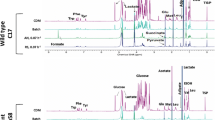Abstract
Campylobacter sputorum subspecies bubulus was grown in continuous culture with excess of l-lactate or formate, and growth-limiting amounts of oxygen, fumarate, nitrate or nitrite. l-Lactate was oxidized to acetate, fumarate was reduced to succinate, and nitrate and nitrite were reduced to ammonia. The Y lactate values (g dry weight bacteria/g mol lactate) for the respective hydrogen acceptors were much higher than the Y formate values. Steady state cultures on formate and nitrite could only be obtained at a low dilution rate and low nitrite concentrations in the growth medium. In →H+/2e measurements with lactate-grown cells proton ejections were observed with lactate or pyruvate as a hydrogen donor, and oxygen or hydrogen peroxide as a hydrogen acceptor. Proton ejection was also observed with pyruvate and nitrate. Proton ejection did not occur with lactate and nitrate, neither with lactate or pyruvate and fumarate or nitrite. With formate as a hydrogen donor acidification occurred with all hydrogen acceptors mentioned. It has been concluded that during growth on lactate and fumarate or nitrite substrate level phosphorylation at acetate formation is the sole ATP-generating system. Growth on formate and fumarate or nitrite is explained by a proton gradient generated as a result of oxidation of formate at the periplasmic side of the cytoplasmic membrane. With oxygen and nitrate additional ATP is formed by electron transport-linked phosphorylation. The low molar growth yields with formate are explained by the observation that formate-grown cells had a great permeability to protons.
Similar content being viewed by others
Abbreviations
- → H+/2e value:
-
number of protons ejected per electron pair transported in the respiratory system
- P/2e value:
-
mol of ATP formed per electron pair transported in the respiratory system
- CCCP:
-
carbonyl cyanide m-chlorophenyl-hydrazone
References
Bernhard, T., Gottschalk, G.: Cell yields of Escherichia coli during anaerobic growth on fumarate and molecular hydrogen. Arch. Microbiol. 116, 235–238 (1978)
Cole, J. A.: The rapid accumulation of large quantities of ammonia during nitrite reduction by Escherichia coli. FEMS Microbiol. Lett. 4, 327–329 (1978)
Da Fonseca-Wollheim, F.: Direkte Plasmaammoniakbestimmung ohne Enteiweißung. Z. Klin. Chem. Klin. Biochem. 11, 426–431 (1973)
Hadjipetrou, L. P., Stouthamer, A. H.: Energy production during nitrate respiration by Aerobacter aerogenes. J. Gen. Microbiol. 38, 29–34 (1965)
Hasan, S. M., Hall, J. B.: The physiological function of nitrate reduction in Clostridum perfringens. J. Gen. Microbiol. 87, 120–128 (1975)
Inderlied, C. B., Delwiche, E. A.: Nitrate reduction and the growth of Veillonella alcalescens. J. Bacteriol. 114, 1206–1212 (1973)
Kröger, A.: Phosphorylative electron transport with fumarate and nitrate as terminal hydrogen acceptors. Symposium 27 of the Society for General Microbiology (B. A. Haddock, W. A. Hamilton, eds.), pp. 61–93. London, New York, Melbourne: Cambridge University Press 1977
Laanbroek, H. J., Stal, L. J., Veldkamp, H.: Utilization of hydrogen and formate by Campylobacter spec. under aerobic and anaerobic conditions. Arch. Microbiol. 119, 99–102 (1978)
Laanbroek, H. J., Veldkamp, H.: Growth yield and energy generation in anaerobically-grown Campylobacter spec. Arch. Microbiol. 120, 47–51 (1979)
Lang, E., Lang, H.: Spezifische Farbreaktion zum direkten Nachweis der Ameisensäure. Z. Anal. Chemie 260, 8–10 (1972)
Linton, J. D., Griffiths, K., Harrison, D. E. F., Bull, A. T.: Growth of Beneckea natriegens on mixtures of glucose and formate in chemostat culture. Soc. Gen. Microbiol. Quarterly 6, 91 (1979)
Meyer, E. M., van Verseveld, H. W., van der Beek, E. G., Stouthamer, A. H.: Energy conservation during aerobic growth in Paracoccus denitrificans. Arch. Microbiol. 112, 25–34 (1977)
Meyer, E. M., van der Zwaan, J. W., Wever, R., Stouthamer, A. H.: Anaerobic respiration and energy conservation in Paracoccus denitrificans. Functioning of iron-sulfur centers and the uncoupling effect of nitrite. Eur. J. Biochem. 96, 69–76 (1979)
Mitchell, P., Moyle, J.: Respiration driven proton translocation in rat liver mitochondria. Biochem. J. 105, 1147–1162 (1967)
Niederman, R. A., Wolin, M. J.: Requirement of succinate for the growth of Vibrio succinogenes. J. Bacteriol. 109, 546–549 (1972)
Niekus, H. G. D., de Vries, W., Stouthamer, A. H.: The effect of different dissolved oxygen tensions on growth and enzyme activities of Campylobacter sputorum subspecies bubulus. J. Gen. Microbiol. 103, 215–222 (1977)
Niekus, H. G. D., Wouters, C. H., de Vries, W., Stouthamer, A. H.: Superoxide dismutase and hydrogen peroxide formation in Campylobacter sputorum subspecies bubulus. Arch. Microbiol. 119, 37–42 (1978)
van Palenstein Helderman, W. H., Rosman, J.: Hydrogen —dependent organisms from the human gingival crevice resembling Vibrio succinogenes. Antonie van Leeuwenhoek J. Microbiol. Serol. 42, 107–118 (1976)
Pirt, S. J., Callow, D. S.: Exocellular product formation by microorganisms in continuous culture. I. Production of 2,3-butanediol by Aerobacter aerogenes in a single stage process. J. Appl. Bacteriol. 21, 188–205 (1958)
Scholes, P. B., Mitchell, P.: Respiration — driven proton translocation in Micrococcus denitrificans. J. Bioenerg. 1, 309–323 (1970)
Thauer, R. K., Jungermann, K., Decker, K.: Energy conservation in chemotrophic anaerobic bacteria. Bacteriol. Rev. 41, 100–180 (1977)
van Verseveld, H. W., Meyer, E. M., Stouthmer, A. H.: Energy conservation during nitrate respiration in Paracoccus denitrificans. Arch. Microbiol. 112, 17–23 (1977)
de Vries, W., Stouthamer, A. H.: Fermentation of glucose, lactose, galactose, mannitol and xylose by bifidobacteria. J. Bacteriol. 96, 472–478 (1968)
de Vries, W., Rietveld-Struyk, T. R. M., Stouthamer, A. H.: ATP formation associated with fumarate and nitrate reduction in growing cultures of Veillonella alcalescens. Antonie van Leeuwenhoek J. Microbiol. Serol. 43, 153–167 (1977)
Wood, P. M.: A chemiosmotic model for sulphate respiration. FEBS Lett. 95, 12–18 (1978)
Author information
Authors and Affiliations
Rights and permissions
About this article
Cite this article
de Vries, W., Niekus, H.G.D., Boellaard, M. et al. Growth yields and energy generation by Campylobacter sputorum subspecies bubulus during growth in continuous culture with different hydrogen acceptors. Arch. Microbiol. 124, 221–227 (1980). https://doi.org/10.1007/BF00427730
Received:
Issue Date:
DOI: https://doi.org/10.1007/BF00427730




